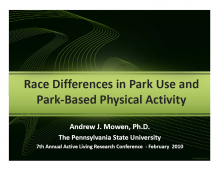We are pleased to announce an exciting new alliance between Active Living Research and GP RED to co-host and coordinate...
Race Differences in Park Use and Park-Based Physical Activity

Presentation at the 2010 Active Living Research Annual Conference
Background:
Health inequalities in obesity and physical activity (PA) exist between African Americans and Whites. Parks are increasingly being studied as low-cost settings in which to promote PA and other health-related benefits, yet little is known about how African Americans and Whites use parks for PA.
Objectives:
To describe differences in park-use behaviors and park-based physical activity (PBPA) between African Americans and Whites in New Orleans.
Methods:
219 African-American (56%) and White (44%) adults were interviewed in 28 New Orleans neighborhood parks during summer 2008. Respondents reported on the type of activity they were doing in the park, the planned duration of their park visit, companions, and motivations for coming to the park (active, social, and escape). Participants self-reported their level of PA in the park, which was dichotomized as moderate-to-vigorous physical activity (MV-PBPA) or less. To explore whether racial differences in park-use behaviors were related to MV-PBPA, a stratified analysis was conducted, and interaction terms were examined.
Results:
African Americans were more likely than Whites to report engaging in MV-PBPA during their park visit (68% vs. 52%, p=0.025) and to stay longer in the park (126 minutes (SD 113.5) vs. 53 minutes (SD 38.2), p<0.0001). African Americans were more likely to come with children (55% vs. 32%, p=0.001) while Whites were more likely to come alone (50% vs. 33%, p=0.012). Whites were more likely to report walking their dog in the park (58% vs. 5%, p<0.0001) or socializing (21% vs. 5%, p=0.001), while African Americans were more likely to report watching a sporting event (32% vs. 3%, p<0.0001) or playing team sports (29% vs. 6%, p<0.0001). With regard to park-use motivations, “active,” “social,” and “escape” reasons for visiting the park were significantly more important to African Americans than Whites.
Among African Americans (Table), higher odds of MV-PBPA were associated with frequency of park visits, total time spent in park, playing team sports, and having “active” motivations for visiting the park, while female gender, age, and watching a sporting event were associated with lower odds of MV-PBPA. Among Whites, time spent in the park, coming and playing with children, and having “social” motivations for park use were associated with higher odds of MV-PBPA, while coming alone and walking the dog were associated with lower odds of MV-PBPA.
Between African Americans and Whites, certain characteristics had different effects on MV-PBPA, indicated by a significant race interaction. Frequency of park visits and coming to the park alone were associated with higher MV-PBPA among African Americans but lower MV-PBPA among Whites, while coming to the park with children was associated with lower MV-PBPA among African Americans but higher MV-PBPA among Whites.
Conclusions:
African Americans and Whites differ on how they use their neighborhood parks in many respects. When designing parks and programming to increase park-based physical activity for both races, park managers should explore ways to increase the duration of park visits, to encourage playing with children, and to encourage playing team sports. They should also explore ways to make dog-walking in the park and watching sporting events less sedentary activities. However, some important differences exist between the races that should also be considered for planning. For African Americans, in particular, park managers should encourage greater frequency of park visits, while for Whites; park managers should encourage park visits with children.
Support:
This research was supported by Cooperative Agreement Number 5K01DP000088 from the CDC.
STAY UP TO DATE
RECENTLY ADDED TOOLS & RESOURCES
MOVE! A BLOG ABOUT ACTIVE LIVING
The "Active Living Conference" aims to break down research and practice silos and...







